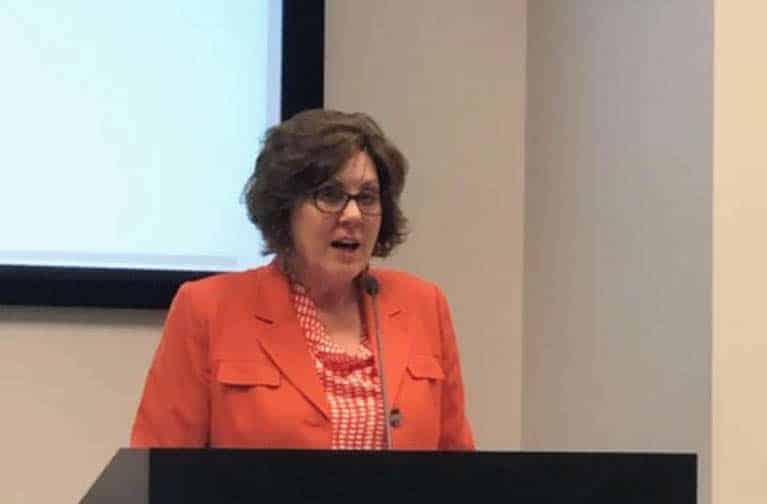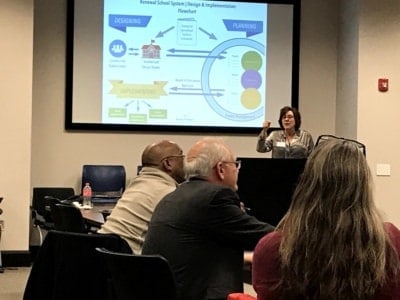

The Rowan-Salisbury School Board, in an almost four-hour meeting last week, discussed consolidation of elementary schools, an updated model for accountability under renewal, and the promise of a new K-8 school to replace Knox Middle School and Overton Elementary. The meeting was contentious at times, but it resulted in directives for administration to provide plans at the next business meeting.
Architects Paul Boney and Ginny Magrath from LS3P once again presented a conceptual plan for building a K-8 school on existing athletic fields between Knox and Overton. During construction, students would continue to attend their respective schools, and after construction, the original schools would be demolished for athletic fields and parking. LS3P has been presenting conceptual ideas for this project for over a year.
The presentation came as a result of community backlash against upfitting Knox, placing Knox students in Overton during construction, and placing Overton students in nearby elementary schools. Knox was built in 1958 in a distributed campus style, which was popular at the time. It has seven buildings with over 50 exterior doors. Students travel outside from class to class, and many in the community feel this presents a security threat.
The proposed plan lays out administrative areas — offices, cafeteria, and media — in the center of the complex, with elementary classes to the west and middle school classes to the east. The gym would be located on the east as well. The plan also provides an enclosed courtyard in the center. Boney did note that the plan is conceptual only, and said that they are “many iterations away” from a final plan.
Construction is estimated at a total of about $50 million, including soft costs such as surveying, permits, furniture, and fixtures.
The board anticipates receiving a total of $81.5 million from the county. They recently spent $6.5 million on various HVAC needs throughout the county. Board member Dean Hunter pointed out that if they spend $50 million on one school, they are left with only $25 million, which will not build a school. The board has recently discussed building consolidated elementary schools in the eastern and southern parts of the county to enable closing older schools. The need for addressing Knox arose from a mediation with the school board and the county in 2014.
City of Salisbury school board representative Alysha Byrd-Clark made the motion to proceed with a plan for a K-8 school to replace Knox and Overton. The motion passed, 4-2, with Hunter, west district, and Travis Allen, south district, dissenting. Former chair Josh Wagner was absent from the meeting.
As requested in the last meeting, Assistant Superintendent for Operations Anthony Vann presented a recommendation for school closures. He advised the board to close Enochville Elementary School, located in the southern portion of the county. Three citizens spoke at public comment against Enochville’s closure: two teachers and a parent.
The district has 2,556 empty seats among its elementary schools. In fall of 2018, the district held six community meetings across the county to communicate the necessity of closing some schools so that more dollars can go towards instruction rather than to maintaining aged buildings. The meetings were attended by hundreds of interested parents and students. The board had recently opened a new elementary school that combined two community schools, but has not taken action since the district’s campaign over a year ago.
Hunter questioned Enochville as the choice for closure. He referred to the capital needs assessment, developed in 2017 by a volunteer citizen committee under school board direction. It ranked schools by a number of factors including physical condition, capital needs, and energy cost per student.
Referring to the assessment, Hunter asked how Enochville was chosen.
“The bottom three schools were Morgan, Granite Quarry, and Faith. I don’t know how we moved from focusing on the east area, the bottom three, to today jumping to number eight on the list to isolate for closure,” said Hunter. “Based on the capital needs committee, who did a lot of research and a lot of time, we are ignoring their recommendation and going to a school that’s in the middle of the top of the pack. Enochville was built in 1935. These east schools average (a build year of) 1925.”
Superintendent Dr. Lynn Moody responded, taking full accountability for the decision. She cited Enochville as having the lowest enrollment in the county at 280 students. Closing Enochville would affect the fewest number of students. They would be distributed to only two nearby schools.
“I will remind you when I arrived six years ago, the first thing I said was, ‘We have too many schools.’ Most recently, we were asked to bring a recommendation about a K-8 and bring a recommendation for a closure,” said Moody. “That’s what we’ve done.”
“We are happy to provide information, but please take action. Do I want to close Enochville? Heck no. We give you a strategic plan, we take it to the public, then people are afraid. Please develop a timeline,” said Moody.
The board engaged in a great deal of discussion. Hunter moved to request a formal plan to close three elementary schools in the 2021-22 school year when Travis Allen, vice chairman of the board, spoke up.
“It’s difficult for me to believe we will take action on three at our next meeting when they recommended one tonight, and we can’t take action on that. This room will be filled out the hall and we won’t take action,” said Allen. “We have no guts. We can’t close three in two years. We can’t close one tomorrow. I don’t see us having the guts to do two or three when we can’t even do one.”
Moody restated the motion for clarity.
“The way I’m taking this motion is to go back to the study originally done by the committee, update the enrollment figures and update HVAC information. Bring it back to you as objectively as we can, using the facts, and bring you the two bottom schools on that chart and you close them based on that,” she said. “I am not confident it would yield three. I am confident of two, perhaps three.”
The motion passed, 3-2, with Jones and Jean Kennedy, an at-large member, dissenting. Byrd-Clark had excused herself from the meeting and was not present for the vote.
Another portion of Vann’s recommendation was to do something with Henderson Independent School, but he stopped short of saying exactly what to do about it.
Henderson started out as an elementary school in 1920. It closed in the 1990s. Ten or so years later, it was reopened as an alternative school, serving students who have challenges succeeding in a traditional school setting. Vann has identified over $3 million in capital needs at Henderson alone.
Henderson has a capacity of 180 students but currently serves about 50. That number fluctuates during the year as more students are referred to the school or return to their original schools after some time. It has the highest energy cost per student in the district at $419.75. By comparison, many schools’ energy cost is in the $120 to $130 range.
Hunter requested that staff prepare a specific recommendation for action on Henderson at the next meeting. The motion passed unanimously.
In other business, Chief Strategy Officer Andrew Smith shared more details on the accountability model for renewal. Initially the plan was to share measures on students’ interpersonal skills. As the teacher-led design team dug deeper, however, they decided it was in the students’ interest to maintain privacy on their growth in interpersonal skills and have only teachers and parents see that information, while students will reflect on their growth.




